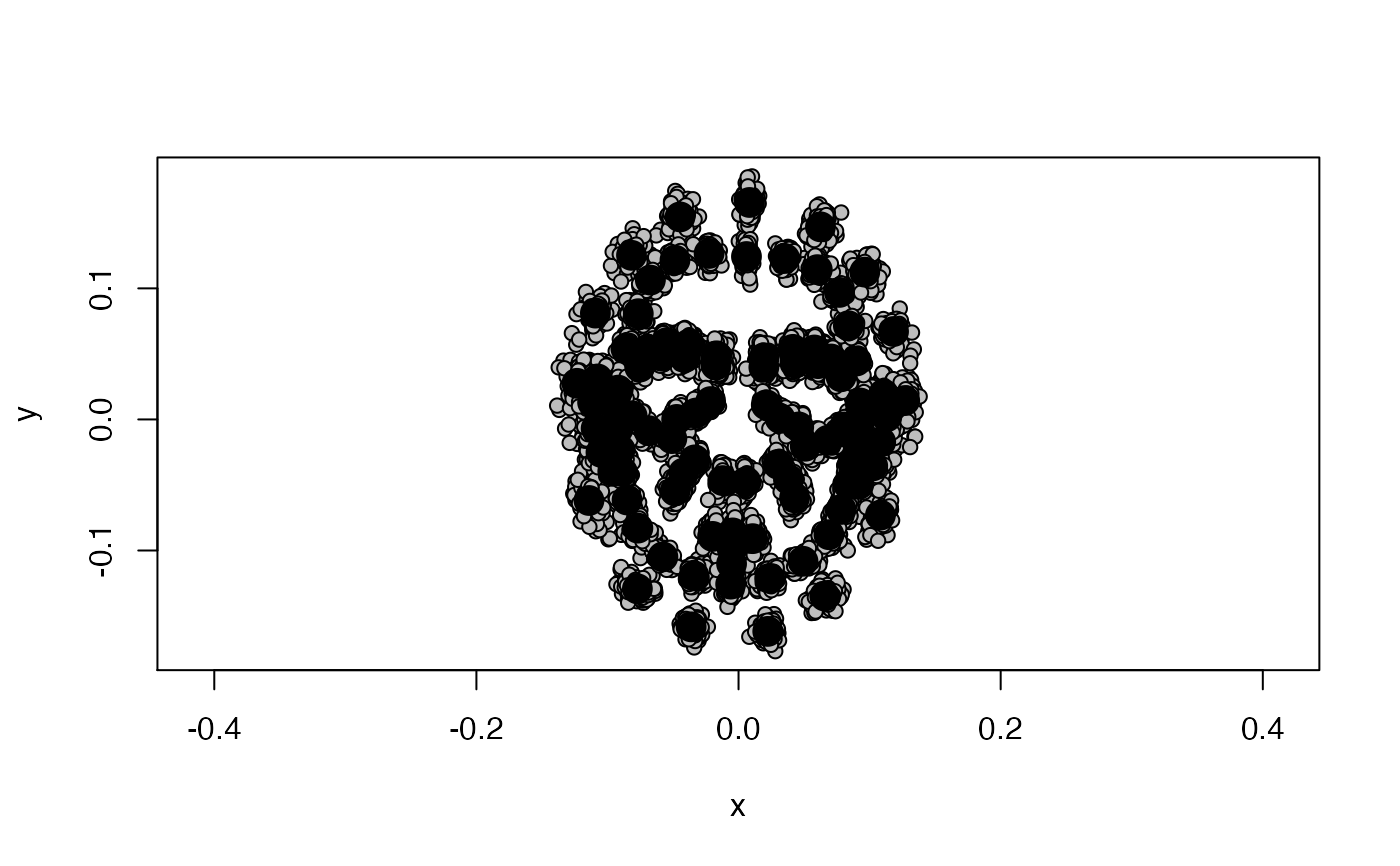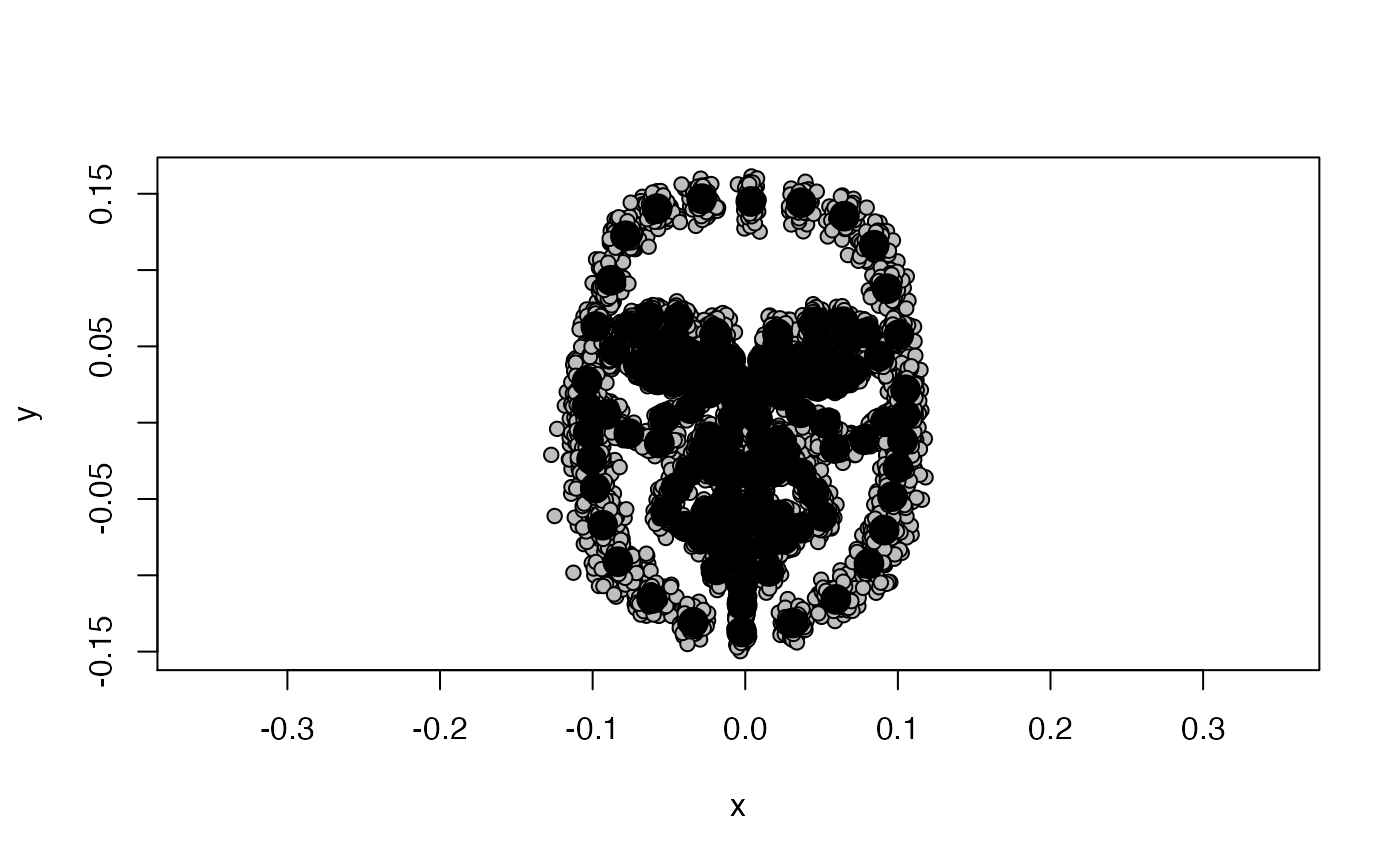Performs some of the routine steps for getting landmark data ready for shape analyses, such as Procrustes alignment and principal component analysis. For more details see vignette:
vignette("intro", package = "facefuns")
facefuns( data, remove_points = NULL, pc_criterion = "broken_stick", plot_sample = TRUE, auto_rotate = TRUE, quiet = FALSE )
Arguments
| data | Array of dimensions p, k, and n, where p = number of landmarks/vertices, k = dimensionality of data (2 or 3), n = number of specimens |
|---|---|
| remove_points | Specify any points/landmarks you want to remove prior to analyses. See remove_points and frl_features for more info |
| pc_criterion | Criterion used to choose which PCs to retain. See select_pcs |
| plot_sample | Plot sample to check data. See plotAllSpecimens |
| auto_rotate | Landmark templates are sometimes no longer upright after Procrustes-alignment. Auto-rotate uses rotate.coords to guess which type of rotation is required |
| quiet | Set to FALSE to suppress short summary of loaded data in console |
Value
Returns a list of the following components:
Three-dimensional array containing Procrustes-aligned data
Coordinates of sample average for plotting
List of selected PCs (including their SD, variance explained and cumulative variance explained), number of selected PCs, criterion used to select PCs
Principal component scores
PCs for plotting. Will by default create list of coordinates for all selected PCs at +/- 3SDs. To create plots of other PCs or at different level of SD, please see make_pcs or plot_2dpcs
Short summary of key descriptives
Examples
################ ### 2-D DATA ### ################ path_to_tem <- system.file("extdata", "tem", package="facefuns") data2d <- read_lmdata(lmdata = path_to_tem)shapedata2d <- facefuns(data = data2d, pc_criterion = "broken_stick")#> All landmarks were used in analyses. #> The loaded data set contains 102 specimen, delineated with 189 2-D landmarks. #> The broken_stick criterion was used to select 8 principal components. #> Templates were rotated using "rotateC" after the GPA.# REMOVING POINTS # You can also remove points from your landmark templates prior to analyses shapedata2d <- facefuns(data = data2d, remove_points = c("left_eye", "right_eye", "nose", "mouth"))#> You removed 93 landmarks prior to analyses. #> The loaded data set contains 102 specimen, delineated with 96 2-D landmarks. #> The broken_stick criterion was used to select 9 principal components. #> Templates were rotated using "rotateC" after the GPA.#> You removed 25 landmarks prior to analyses. #> The loaded data set contains 102 specimen, delineated with 164 2-D landmarks. #> The broken_stick criterion was used to select 8 principal components. #> Templates were rotated using "rotateC" after the GPA.shapedata2d <- facefuns(data = data2d, remove_points = "frlgmm")#> You removed 57 landmarks prior to analyses. #> The loaded data set contains 102 specimen, delineated with 132 2-D landmarks. #> The broken_stick criterion was used to select 8 principal components. #> Templates were rotated using "rotateC" after the GPA.# PLOT AlIGNED TEMPLATES shapedata2d$summary$plot_sample() #or geomorph::plotAllSpecimens(shapedata2d$aligned)#> [1] "/var/folders/lh/555rbl4x0yvbf8n6w709q7kh0000gn/T//Rtmpouu1D0/fileeac6f0e1b0f.png" #> attr(,"class") #> [1] "knit_image_paths" "knit_asis"# To plot PCs at different levels of SD: pca <- geomorph::gm.prcomp(shapedata2d$aligned) plot_2dpcs(pca, ref = shapedata2d$average, which_pcs = 1:2, vis_sd = 5)#> [1] "/var/folders/lh/555rbl4x0yvbf8n6w709q7kh0000gn/T//Rtmpouu1D0/fileeac712aebf.png" #> attr(,"class") #> [1] "knit_image_paths" "knit_asis"# To save PC plots if (FALSE) { plot_2dpcs(shapedata2d, which_pcs = 1:2, output = "plotpcs.pdf") } ################ ### 3-D DATA ### ################ path_to_ply <- system.file("extdata", "ply", package="facefuns") data3d <- read_vertices(path_to_ply)#> #> #>shapedata3d <- facefuns(data = data3d, pc_criterion = "broken_stick")#> The loaded data set contains 12 specimen, containing 30204 vertices. #> The broken_stick criterion was used to select 2 principal components.




